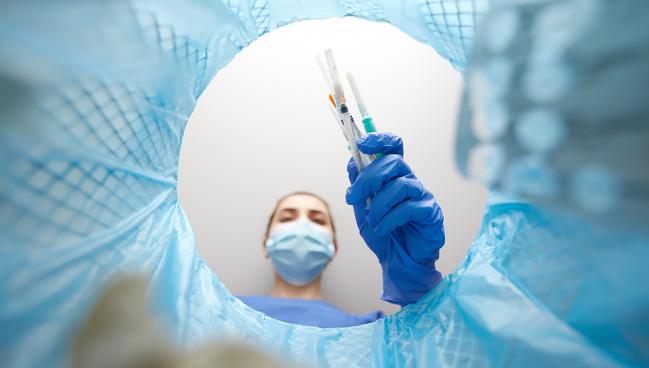Cath Lab Garbage: ‘What Are We Going to Do About It?’
Aghast at the sheer volume of plastic waste and packaging after a simple PCI, Richard Bogle wants companies to find real solutions.

The amount of garbage at the end of the case couldn’t be ignored. The plastic, the packaging, the instruction booklets—all of it stacked on a table and heading for the nearest landfill.
Richard Bogle, MD, PhD (Epsom and St Helier University Hospitals NHS Trust & St George's University Hospitals NHS Foundation Trust, London, England), who’d just completed a relatively routine two-vessel PCI requiring three stents, couldn’t get over the volume of waste produced by this single case.
“You have these situations where you normally don’t think anything about it, and just carry on with your work, but I was thinking about all of this and said to my fellow, ‘This is crazy,’” Bogle told TCTMD. “And he agreed with me, and then everyone in lab said the same thing. So, we asked, what are we going to do about it?”
Successful 2 vessel stenting with 3 stents. Great PCI result but guys what about the environmental impact of all this plastic waste @AbbottCardio @bostonsci Do we recycle? What is industry doing to reduce packaging? #SustainableCardiology pic.twitter.com/OSsTetCUe4
— Richard Bogle (@richardbogle) May 2, 2023
Bogle took to Twitter. Instead of tweeting before-and-after angiograms to showcase the team’s technical proficiency, he laid all the plastic and paper packaging on the table for the cardiology community to see, tagging Boston Scientific and Abbott Cardiovascular in the process. The pile of waste included the 60-page manual that’s included with the stent.
“I thought if you need to read the manual, people, you shouldn’t be doing this procedure,” said Bogle, who dubbed his Twitter campaign #sustainablecardiology.
The manual itself hasn’t been updated in years and is inevitably dumped unread into the recycling bin, said Bogle. Based on his back-of-the-envelope calculation, there are close to 60 million instruction manuals printed each year, and while there may be regulatory or legal reasons for including it, a simple solution would be a QR code on the box, he said.
More problematic, though, are the mounds of waste generated from all the equipment needed to perform PCI. Even the simplest of cases leads to a tremendous amount of mostly unrecyclable garbage.
“With most cases, even if you were to just do a single stent, you’d probably use at least two balloons, maybe three, plus the stent, plus the wires, plus the sheath, plus IVUS, and on it goes,” he said. “The funny thing is inside those boxes every stent comes in its own packet, but it's like one of those games you play as a kid where you’re unwrapping the parcel and there's another wrapper layer inside. You've got the stent in its hoop, and that stent is in a sterile bag, and that sterile bag is in a foil bag, and that foil bag is in a cardboard box.”
One easy way for operators and staff to reduce the amount of waste is to only open what they need instead of anticipating what might be required, said Bogle. And while he and his fellow lab members are willing to do their part, he’d like the companies to find solutions, too.
“I understand that the product has to be stored properly, and it has to be in a sterile bag, but I don't think that companies have really actually looked at what they could do to facilitate a more-sustainable approach,” he said.
Physicians Want to Reduce Their Impact
Medicine is well known to have a massive carbon footprint, attributable to single-use devices, packaging and shipping, medical waste, plastic pollution, and depletion of rare resources, such as platinum.
Estimates of the amount of waste generated by the healthcare sector varies. Much of this waste either ends up in landfills or is incinerated. One Canadian study found that the healthcare sector was responsible for 4.6% of total greenhouse gas emissions, a contribution that’s similar in the United Kingdom. Healthcare’s role in greenhouse gas emissions in Australia and the United States has been estimated to be as high as 7% and 10% of national emissions, respectively.
In March at the American College of Cardiology/World Congress of Cardiology meeting, researchers found that a single cardiac catheterization laboratory produced more than 115 lbs of uncontaminated, potentially recyclable materials in a week, with the greatest waste generated from PCI cases. They estimated that this amounts to nearly 3 million lbs of paper and plastic that ends up in landfills each year.
Given healthcare’s impact on the planet, physicians are rightly concerned. In a survey published last year, more than 80% of electrophysiologists (EPs) said they were highly motivated about environmental issues in their personal lives, with 62% saying they would also like to reduce the environmental impact of their practices. At present, though, roughly 70% of EPs said that the packaging they see ends up in the garbage, with less than 20% of the materials recycled.
I thought if you need to read the manual, people, you shouldn’t be doing this procedure. Richard Bogle
To TCTMD, Bogle said the Twitter post seemed to resonate with physicians and he hopes #sustainablecardiology can start a conversation with industry, starting with acknowledgement of the scope of the problem.
“We can only tackle climate change by everybody doing their part, their small part, because when you add up the small parts together, then we can change everything,” he said. “But it's no good saying, ‘Oh well, you know, we're just a tiny part so we're going to leave it to those guys to do it,’ because everyone's saying that and no one's doing it.”
Bogle suggested awarding companies an independently assessed sustainability index that hospitals and healthcare systems can use to make purchasing decisions. He predicts no company would say the environment is not a concern, and that they’re not doing everything possible to reduce, reuse, and recycle. But real change might come about if it affects their bottom line.
“You could build things into procurement,” he said. “When you look at tenders, there should be a sustainability index: what is the company doing? How sustainable or how environmentally friendly is the product? That would feed into the equation that you use when you decide on a manufacturer. As soon as you start doing that, manufacturers will take this seriously because it's actually going to matter whether they get that contract or not.”
Contacted by TCTMD, several device manufacturers said they are trying to reduce their global footprint.
Justin Paquette, Abbott’s director of public affairs in the cardiovascular division, said the company is working to reduce the environmental impact of product packaging. As part of their global sustainability plan, the company wants to “address 50 million pounds of packaging” through design programs that focus on recycling and reusing resources, he said. As one example, Paquette cited their latest glucose monitoring system (Freestyle Libre 3) that is now significantly smaller, with less plastic use and packaging.
Boston Scientific also said it’s trying to reduce packaging materials while maintaining quality standards for sterile medical devices. Where regulations allow, the company has shifted to digital instructions for use/e-labelling and it uses recyclable materials where possible, according to spokesperson Kate Haranis. They have reduced carton weight, packaging weight, and even insert cards for some products, she said.
At the time of publication, Medtronic hadn’t responded to requests for comment. AdvaMed, the trade organization representing companies that produce and manufacture medical devices, hadn’t either.
Bogle, at the moment, isn’t too impressed. Most of the major manufacturers have sections on their website devoted to sustainability, but he’d like to see something tangible change in the cath lab.
“Show me what you’ve really done,” he said. “I do think suppliers and medical device companies have to do their bit.”
Michael O’Riordan is the Managing Editor for TCTMD. He completed his undergraduate degrees at Queen’s University in Kingston, ON, and…
Read Full Bio




Comments